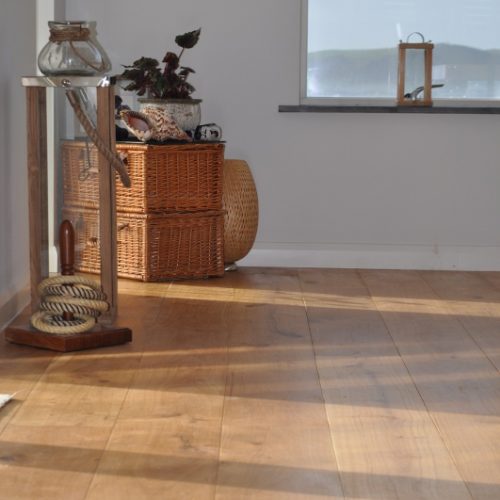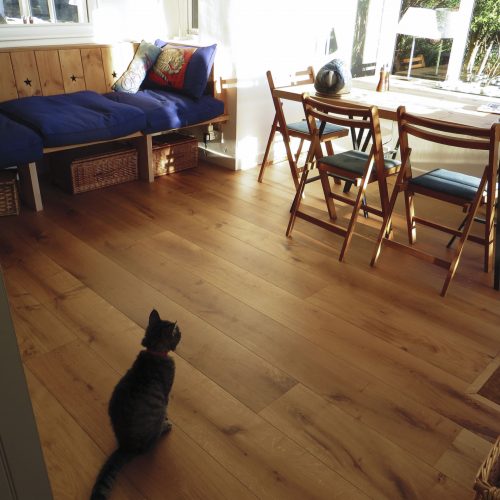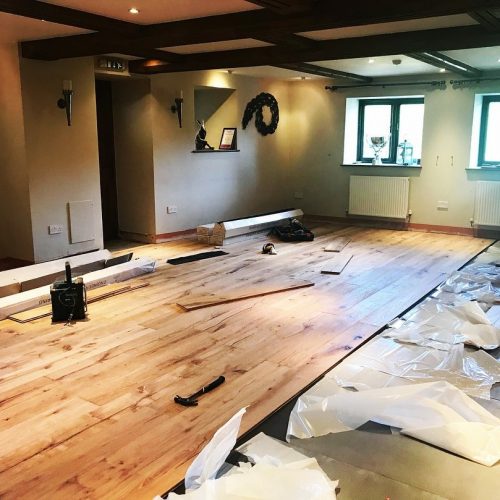An engineered wood floor is a great option for your home. Reliable, versatile, and created from real wood, it’s the perfect way to update your interior décor with a warm and cosy feel.
What does ‘engineered’ mean?
Put simply, an engineered board is made up of more than one solid section of timber.
The top surface of the board, commonly known as the wear layer, is the desired hardwood (oak/walnut) that you will see once the floor is laid. This varies in thickness depending on the spec and overall thickness of the board. Beneath the wear layer is what is often known as the under-core.

Less Likely To Warp
It can vary in quality, but we would always recommend that if you’re looking for a high-quality, stable and reliable hardwood floor, you choose an option which has a multi-laminate plywood under-core. This is made up of multiple layers of wood, each stuck in opposite directions to one another, which makes the board much more stable and far less likely to swell and shrink in comparison to a solid.
The clever construction of the boards makes it safer for use in environments that would prove harsh for real wood floors, such as bathrooms and kitchens, which are likely to experience higher levels of temperature and humidity.
Likewise, engineered wood is robust enough to be used above the under-floor heating that is becoming increasingly popular in modern-day homes.
The combination of a stunning hardwood top surface and high-quality multi-laminate plywood core brings about all the aesthetic benefits of good quality, gorgeous hardwood, which is all the eye sees after installation – along with a reliable, hassle-free construction.
There are also a lot of other great features to this type of flooring…..
It Looks Just Like Real Hardwood
Undoubtedly, the best thing about engineered wooden flooring is that it looks just like a beautiful solid wood board floor. It’s not a laminate!
The timber that is used on the top surface is the same timber that’s used in a solid hardwood board, and therefore, visually, you can tell no difference. In fact, some will consider that engineered hardwood flooring has the potential to look nicer due to the varying dimensions available, more on this below.
Wider Boards
When it comes to solid timber flooring, the wider and longer the floorboard, the more it tends to swell and shrink. Contrastingly, engineered options are much more stable due to their construction as described above. This allows you to go for much larger floorboards with far less worry in terms of movement within the floor.
What’s more, the techniques used to create this type of flooring enable the creation of wider floor boards at a cost-effective price. The dimensions of wooden boards are usually dictated by the size of trees from which you cut them. Wide & long boards of a high grade require much larger sections of the tree, making wide boards expensive in full solid oak boards in comparison to engineered, as well as more difficult to source.
For me, it’s a case of personal preference as to what looks best when comparing wide and long vs narrower and short, but one thing that is certain – the time saving when it comes to fitting. Larger floorboards are so much quicker to lay, so you could enjoy a much faster install process with a larger board size.
Tom Fanthorpe, Director @ JFJ Wood Flooring

Simple To Install
Due to their stability and accuracy of machining, you also tend to find that they are much easier to fit in general. Where solid wood options tend to be a little more challenging (slotting boards together, getting joints tight, etc), engineered is much easier to work with.
Whether your floor is being professionally laid or you’re planning to indulge in some DIY, there’s a distinct benefit to choosing engineered flooring over traditional alternatives. You can see our guide to fitting and finishing.
Extensive Variety
Another great benefit of these floors is the wide range of grades, dimensions, colours, and finishes available. Particularly in oak.
With much more choice on the market, it’s generally much easier to find one that is to your tastes, purpose, design and lifestyle, not to mention your budget!

Cost-Effective
While engineered hardwood looks just like the real thing, it can also be more affordable. Particularly on timbers such as American Black Walnut, which is a more expensive, luxurious product.
Within this board, the majority of the structure is made up of the multi-laminate plywood undercore – meaning that less valuable walnut is used. That makes it both more affordable and more environmentally friendly.
The same often applies with European oak boards, though the European oak is more affordable than Walnut and therefore the price difference is not quite as noticeable. Some floorboards will, in fact, be dearer than solid oak due to their specification; however, most tend to be cheaper or similarly priced.
Our family has been in the timber, carpentry and flooring businesses for over 100 years. Over that time, we’ve evolved the products that we sell and now, we mostly focus on engineered wood flooring. Quite simply, it is unbeatable for the combination of quality, reliability and value for money it provides.
John Fanthorpe, Director @ JFJ Wood Flooring
Sand It Like A Solid Wood Floor
As mentioned earlier in this article, the top layer of the board is real wood, meaning it can be sanded and refinished just like a solid wooden floor.
How many times you can sand down your floor will depend on exactly how thick the top layer (lamella/wear layer) is. If you purchase a floor with a 6mm wear layer, such as our ‘21mm thick Supreme range’, then you can sand this floor back just as many times as you could a solid.
Durability
The durability of a wooden engineered floor will be dependent on the quality of finish that has been used to treat the timber. This is the same as solid hardwood because the top layer of wood on an engineered board is the same. We have an article dedicated to the question “Is solid oak more durable than engineered?” which can be found here.
If you’re looking for the perfect engineered floor, take a look at our range of oak and walnut flooring. If you have any questions, please do not hesitate to be in touch via phone or email. As a family business, we will always be happy to answer any of your questions.
